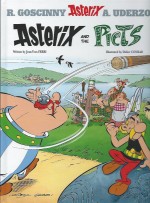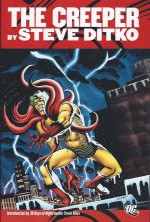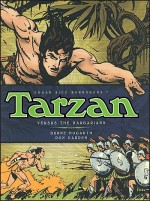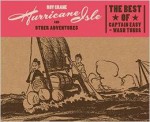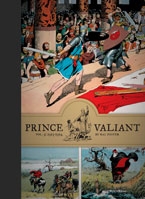

By Jerry Siegel, Wayne Boring, Curt Swan &Stan Kaye with Otto Binder, Leo Dorfman, Edmond Hamilton, Bill Finger & Robert Bernstein (IDW Publishing Library of American Comics)
ISBN: 978-1-6137-7923-1
It’s indisputable that the American comicbook industry – if it existed at all – would have been an utterly unrecognisable thing without Superman. Jerry Siegel & Joe Shuster’s unprecedented invention was fervidly adopted by a desperate and joy-starved generation and quite literally gave birth to a genre if not an actual art form.
Spawning an impossible army of imitators and variations within three years of his 1938 debut, the intoxicating blend of breakneck, breathtaking action and wish-fulfilment which epitomised the early Man of Steel grew to encompass cops-and-robbers crime-busting, socially reforming dramas, science fiction, fantasy, whimsical comedy and, once the war in Europe and the East sucked in America, patriotic relevance for a host of gods, heroes and monsters, all dedicated to profit through exuberant, eye-popping excess and vigorous dashing derring-do.
In comicbook terms Superman was master of the world. Moreover, whilst transforming the shape of the fledgling funnybook industry, the Man of tomorrow relentlessly expanded into all areas of the entertainment media. Although we all think of Cleveland boys’ iconic invention as the epitome and acme of comicbook creation, the truth is that very soon after his debut in Action Comics #1 the Man of Steel became a fictional multimedia monolith in the same league as Popeye, Tarzan, Sherlock Holmes and Mickey Mouse.
We parochial and possessive comics fans too often regard our purest and most powerful icons in purely graphic narrative terms, but the likes of Batman, Spider-Man, X-Men, Avengers and their hyperkinetic kind long ago outgrew their four-colour origins and are now fully mythologized modern media creatures instantly familiar in mass markets, across all platforms and age ranges…
Far more people have seen or heard the Man of Steel than have ever read his comicbooks. His globally syndicated newspaper strips alone reached untold millions, and by the time his 20th anniversary rolled around at the very start of what we know as the Silver Age of Comics, he had been a thrice-weekly radio serial regular, starred in a series of astounding animated cartoons, two films and a novel by George Lowther.
He was a perennial sure-fire success for toy, game, puzzle and apparel manufacturers and had just ended his first smash live-action television serial. In his future were three more shows (Superboy, Lois & Clark and Smallville), a stage musical, a franchise of blockbuster movies and an almost seamless succession of games, bubblegum cards and TV cartoons beginning with The New Adventures of Superman in 1966 and continuing ever since. Even superdog Krypto got in on the small-screen act…
Although pretty much a spent force these days, for the majority of the last century the newspaper comic strip was the Holy Grail that all American cartoonists and graphic narrative storytellers hungered for. Syndicated across the country – and often the planet – it was seen by millions, if not billions, of readers and generally accepted as a more mature and sophisticated form of literature than comic-books. It also paid better.
And rightly so: some of the most enduring and entertaining characters and concepts of all time were created to lure readers from one particular paper to another and many of them grew to be part of a global culture.
Mutt and Jeff, Flash Gordon, Dick Tracy, Buck Rogers, Charlie Brown and so many more escaped their humble tawdry newsprint origins to become meta-real: existing in the minds of earthlings from Albuquerque to Zanzibar.
Most still do…
So it was always something of a risky double-edged sword when a comicbook character became so popular that it swam against the tide (after all weren’t the funny-books invented just to reprint the strips in cheap accessible form?) to became a genuinely mass-entertainment syndicated serial strip.
Superman was the first original comicbook character to make that leap – about six months after as he exploded out of Action Comics – but only a few have ever successfully followed. Wonder Woman, Batman (eventually) and groundbreaking teen icon Archie Andrews made the jump in the 1940s and only a handful like Spider-Man, Howard the Duck and Conan the Barbarian have done so since.
The daily Superman newspaper comic strip launched on 16th January 1939, supplemented by a full-colour Sunday page from November 5th of that year. Originally crafted by such luminaries as Siegel & Shuster and their studio (Paul Cassidy, Leo Nowak, Dennis Neville, John Sikela, Ed Dobrotka, Paul J. Lauretta & Wayne Boring) the mammoth task soon required the additional talents of Jack Burnley and writers like Whitney Ellsworth, Jack Schiff & Alvin Schwartz.
The McClure Syndicate feature ran continuously until May 1966, appearing at its peak in more than 300 daily and 90 Sunday newspapers, boasting a combined readership of more than 20 million. Eventually artists Win Mortimer and Curt Swan joined the unflagging Boring & Stan Kaye whilst Bill Finger and Siegel provided stories, telling serial tales largely separate and divorced from comicbook continuity throughout years when superheroes were scarcely seen.
Then in 1956 Julie Schwartz kicked off the Silver Age with a new Flash in Showcase #4 and before long costumed crusaders began returning en masse to thrill a new generation. As the trend grew, many publishers began to cautiously dabble with the mystery man tradition and Superman’s newspaper strip began to slowly adapt: drawing closer to the revolution on the comicbook pages.
As Jet-Age gave way to Space-Age, the Last Son of Krypton was a comfortably familiar icon of domestic modern America: particularly in the constantly evolving, ever-more dramatic and imaginative comicbook stories which had received such a terrific creative boost when superheroes began to proliferate once more. The franchise had actually been cautiously expanding since 1954 and in 1961 the Caped Kryptonian could be seen not only in Golden Age survivors Action Comics, Superman, Adventure Comics, World’s Finest Comics and Superboy but also in Superman’s Pal Jimmy Olsen, Superman’s Girlfriend Lois Lane and Justice League of America.
Such increased attention naturally filtered through to the far more widely-read newspaper strip and resulted in a rather strange and commercially sound evolution…
This second expansive hardback collection (spanning August 1961 to November 1963) opens with a detailed Introduction from Sidney Friedfertig, explaining the provenance of the strips; how and why Jerry Siegel was tasked with retuning recently published yarns from the comicbooks; making them into daily 3-and-4 panel black-&-white continuities for the apparently more sophisticated and discerning newspaper audiences.
This frequently required major rewrites, subtle changes in plot, direction and tone and, on occasion, merging more than one story into a seamless new exploit to excite and generally amuse sensible, mature grown-ups.
If you’re a veteran fan, don’t be fooled: the tales retold here might seem familiar but they are not mere rehashes: they’re variations and deviations on an idea for an audience perceived as completely separate from kids’ comics. Even if you are familiar with the original comicbook source material, the adventures presented here will read as brand new, especially as they are gloriously illustrated by Wayne Boring (with a little occasional assistance from Curt Swan) at the very peak of his artistic powers.
After years away from the feature Boring had replaced his replacement Curt Swan at the end of 1961, regaining his position as premiere Superman strip illustrator to see the series to its eventual conclusion.
As an added bonus the covers of the issues those adapted stories came from have been included as a full, nostalgia-inducing colour gallery…
The astounding everyday entertainments by Siegel & Boring commence with Episode #123 from August 14th to September 16th 1961 revealing how timid Clark Kent mysteriously excelled as a policeman whilst wearing a legendary old cop’s lucky tin star in ‘The Super Luck of Badge 77!’: a yarn based on an adventure of the same name by Otto Binder & Al Plastino from Superman #133 (November 1959).
‘Superman’s Hunt for Clark Kent’ (September 18th to 5th November and first seen in Superman #126 January 1959, by Binder, Boring & Stan Kaye) then detailed how a Kryptonite mishap deprived the Man of Tomorrow of many of his memories and left him lost in Metropolis trying to ferret out the secret of his other identity after which Episode #125 – running from November 6th-December 23rd – saw the restored Clark as ‘The Reporter of Steel’ (originally a Binder, Boring & Kaye yarn from Action Comics #257, October 1959) after Lex Luthor very publicly inflicted the mild-mannered journalist with unwanted superpowers, setting suspicious Lois Lane off on another quest to prove her colleague was actually the Caped Kryptonian.
‘The 20th Century Achilles’ ran Christmas Day 1961 through January 20th 1962, adapted from an Edmond Hamilton, Curt Swan & Kaye thriller in Superman #148 (October 1961) which detailed how a cunning crook held the city hostage to his apparent magical invulnerability whilst ‘The Man No Prison Could Hold’ (January 22nd – February 24th by Bill Finger, Boring & Kaye from Action Comics #248, in January 1959) saw Clark and Jimmy Olsen captured by a Nazi war criminal using slave labour to construct a mighty vengeance weapon. Unbeknownst to all the Man of Steel had good reason to foil every escape attempt and stay locked up…
An old-fashioned hard lesson informed the Kryptonian Crimebuster’s short sharp shock treatment of ‘The Three Tough Teenagers’ which ran from February 26th to March 31st, based on a Siegel & Plastino collaboration contemporaneously appearing in Superman #151 (February 1962) at the same time. Perhaps the headline-grabbing nature of youth in revolt was too immediate to resist? Usually timing discrepancies in publication dates could be explained by the fact that submitted comicbook stories often appeared months after they were completed, but here it feels like neither iteration of the franchise was willing to surrender sales-garnering topicality…
Swan illustrated portions of the Siegel/Boring strip version of ‘The Day Superman Broke the Law’ (2nd to 28th April) from the original by Finger & Plastino from Superman #153 May 1962, which saw the hero fall foul of a corrupt city councilman rewriting ordinances to hamper him after which the hero became ‘The Man with the Zero Eyes’ (running 30th April to June 2nd from an uncredited tale in Superman #117, November 1957 and first limned by Plastino) as a space virus caused uncontrollable super-freezing rays to blaze from his eyes.
Spanning 4th – 23rd June ‘Lois Lane’s Revenge on Superman’ grew out of a comedy tale by Siegel, Swan & George Klein in Superman’s Girlfriend Lois Lane #32 (April 1962). Here however there’s a dark edge to the story as the frustrated journalist revels in humiliating her ideal man after a magic potion turns him into a baby whilst ‘When Superman Defended his Arch-Enemy’ – published from 25th June to August 4th as adapted from Action Comics #292 and released in September 1962) by writer unknown & Plastino saw the Metropolis Marvel acting as defence Counsel for the ungrateful mad scientist after the fleeing maniac dismantled a sentient mechanoid on a world of machine intelligences…
Appearing daily from 6th August to September 8th ‘Lois Lane’s Other Life’ retold Siegel, Swan & Klein’s tale from Superman’s Girlfriend Lois Lane #35 (August 1962) as the daring doll changes her appearance to go undercover but subsequently loses her memory after which ‘The Feud Between Superman and Clark Kent’ from September 10th to 27th October (originally by Hamilton & Plastino in Action Comics #292, October 1962) saw the two halves of the hero separated by Red Kryptonite. Sadly the goodness and nobility are all in the merely human Clark part and he must stay out of his merciless alternative fraction’s murderous clutches until the effect wears off…
As first conceived by Siegel, Swan & Klein in Superman’s Girlfriend Lois Lane #38 (January 1963) ‘The Invisible Lois Lane’ – which filled newspaper pages between October 29th and December 1st – was more comedy than drama but here the undetectable investigator quickly sees her quarry switch from Clark to Superman and it takes super-ingenuity to convince her otherwise…
‘The Man Who Hunted Superman’ – December 3rd 1962 to January 19th 1963 – originally appeared as Boy of Steel blockbuster ‘The Man Who Hunted Superboy’ (by Leo Dorfman & George Papp in Adventure Comics #303, December 1962) and found Clark subbing for a prince in a Ruritanian kingdom, complete with adoring and compliant princess bride, until the Action Ace could topple a highly-placed usurper and save the kingdom whilst ‘Superman Goes to War’ January 21st to February 23rd (initiated by Hamilton, Swan & Klein in Superman #161, May 1963) sees Lois and Clark on an film-set sponsored by the US military and inadvertently caught up in a real but unconventional alien invasion…
From February 25th to April 20th Red K stripped our hero of his powers leaving ‘The Mortal Superman’ forced to fake it due to an unavoidable prior engagement in a terse reinterpretation of the Dorfman & Plastino yarn seen in Superman #160, April 1963.
The Man of Steel for good and sound patriotic reasons allowed himself to be locked up for the alleged murder of Clark Kent in ‘The Trial of Superman’ between 22nd April and May 25th, later seen in its original format in Hamilton & Plastino’s thriller from Action Comics #301, June 1963.
Hardworking obsessive editor Perry White loses his memory and falls into the clutches of criminals who use his investigative instincts to uncover Earth’s greatest secret in ‘The Man who Betrayed Superman’s Identity’ – 27th May to July 6th – as adapted from Dorfman, Swan & Klein’s suspenseful romp in Action Comics #297, February 1963, whilst with adult sensibilities fully addressed, genuine tragedy and pathos pushes Siegel & Boring’s reinterpretation of ‘The Sweetheart that Superman Forgot’ running from 8th July to August 17th into the heady heights of pure melodrama as Superman loses his astounding powers, memories, and use of his legs; loving and losing a girl who only wanted him for himself.
In one of the most adult of stories of his canon, the hero recovers his lost gifts and faculties and has no notion of what he’s lost and who waits for him forever alone: a depth of emotion the author could only dream of approaching in the Plastino-illustrated original version which appeared in Superman #165, November 1963).
Painfully locked into the un-PC, sexist comedy tropes of the era, from August 19th – September 14th comes ‘Superman, Please Marry Me’ wherein a novelty record of Lois purportedly begging her ideal man to give in makes the reporter’s life a living hell in a “tweaked-for married-readers†yarn based on ‘The Superman-Lois Hit Record’ by Siegel, Swan & Klein from Superman’s Girlfriend Lois Lane #45 (November 1963) after which ‘Dear Dr. Cupid’ – based on Siegel & Kurt Schaffenberger’s light-hearted turn from Superman’s Girlfriend Lois Lane #45, (November 1963), which ran from September 14th to October 12th – details how the news-hen’s surprising and unsuspected gift for doling out advice as an Agony Auntie leads to a series of disturbing gifts from an unexpected admirer…
This epic chronicle concludes with ‘The Great Superman Impersonation’ from October 14th to November 23 1963 and based on Robert Bernstein & Plastino’s Action Comics #306, (cover-dated November 1963) with Clark kidnapped by foreign agents who want to pass him off as the Man of Tomorrow in order to take over a Central American republic: big mistake, especially as Superman is in a playful mood…
Superman: – The Silver Age Dailies 1961-1963 is the second of three huge (305 x 236 mm), lavish, high-end hardback collections starring the Man of Steel and a welcome addition to the superb commemorative series of Library of American Comics which has preserved and re-presented in luxurious splendour such landmark strips as Li’l Abner, Tarzan, Rip Kirby, Polly and her Pals and many of the abovementioned cartoon icons.
If you love the era, these stories are great comics reading, and this is a book you simply must have.
Superman ™ and © 2014 DC Comics. All Rights Reserved.


